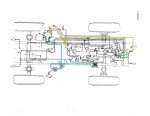There's no need to make the entire trailer brake part of the system operational, just the air feed. It is one line.
Aside from a very convenient (and correct) way to put air into the system, that feed can be used if you ever get towed with a strap or chain, for example, want power assisted brakes and don't like using the clutch as a brake pedal. Or to put enough air in the system to make the 4WD and lockers work, if the machine is otherwise operational.
OK, Still not convinced it is worth it personally because I don't own another vehicle that has air brakes, so probably not likely to get towed. As far as charging the system, If I put the female connector on in place of the factory one which is an idea I like I could do the same thing with a short hose that has the male plug on both ends.

I will stop beating this dead horse now.
Conversion fittings may not be on the shelves at Pep Boys, but they exist in many, many places.
Yeah, I know the fittings will not be that hard to put together, I was mostly asking to make sure that is what you were talking about. I currently down't have the metric to SAE hose fittings, but do have a connector plug, a drill and NPT tap and the old drain plug that is not doing me any good.. I will order the fittings because I think that is a real good idea.
Overall, I think you're making what seems to be a minor issue a lot more complex than it needs to be. Get some pressure into the system whichever way you prefer, then listen for the leak(s).
If someone has removed much of the trailer brake system, I know where I'd start looking...um, listening.
Well if I am making a big deal about it, it is because I made zero progress on it over the weekend. I tried connecting the glad hand to 3 of the 4 possibilities with no results except when I connected it to the back right glad hand and the check valve to prevent what I was trying was slowly leaking. Both front glad hands sealed well and the air went nowhere even when I had disconnected lines by the tanks.
When I first got the thing building up air was the only thing that worked well. So I don't think it is because of an incomplete job on removing the trailer / tow breaks.
Perhaps I am miss understanding or miss reading the diagram.
 View attachment 758688
View attachment 758688
What I have highlighted in Yellow is the line that I can't find. It is I believe missing and runs from the front to the back. The line I have highlighted in green is there, but it is a much smaller in diameter and I believe it is used to signal the brakes into action. The blue highlight just shows the normal path from the compressor to the tank. I really don't see that pressurizing the tank directly is much if any different from pressurizing it from the glad hand. I will take Speedwoble's advice and bring the pressure up slowly to avoid any damage.





 I will stop beating this dead horse now.
I will stop beating this dead horse now.